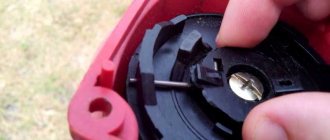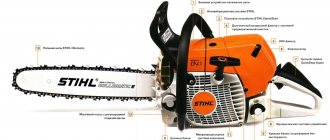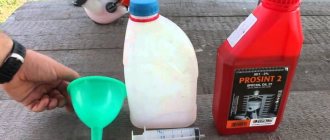Gasoline in the crankcase of a walk-behind tractor Cause
As you know, experts and experienced motorists recommend checking the oil level at least once a week. It should be noted that there are good reasons for this. Regular inspections also make it possible not only to promptly detect a decrease in engine oil level, but also to evaluate the shape and condition of the oil.
In this article we will look at a situation where, upon inspection, it turned out that the engine oil smells like gasoline, gasoline in the engine oil is clearly visible, the reasons for this phenomenon and ways to solve this problem.
How gasoline gets into motor oil and what the consequences may be
So, the topic of the article itself answers the question of whether gasoline can get into motor oil. Indeed, fuel can be in the oil, even in engines with a fully functional cylinder-piston group.
We move on. This problem is quite serious and can lead to malfunctions, a significant reduction in engine life, as well as complete failure of the power plant. Let's see why this happens.
Let's start with the fact that gasoline in oil significantly worsens the protective properties of the oil and dilutes the oil. Without going into details, the more gas that gets into the crankcase, the more serious the consequences.
- With a small amount of fuel in the oil, the engine may run noisier, while wear on stressed components will increase slightly. To solve the problem, it will be enough to eliminate the problem in which gasoline gets into the engine crankcase and replace the engine oil.
- In other cases, driving in highly diluted fuel oil can lead to costly engine repairs.
Below are some of the main features that may, to varying degrees, indicate the problem in question:
- The power unit loses power, fuel consumption increases significantly;
- The exhaust becomes thick, grayish, and smells of unburnt gasoline;
- Malfunctions occur in the internal combustion engine, the engine begins to flicker and goes out;
- The engine started noisily, there were knocks in the area of the pistons, crankshaft and much more.
- The oil level in the crankcase is increased, the smell of gasoline in the engine oil is clearly audible;
- The oil is diluted, a drop of motor oil is easily ignited by an open flame;
A black outline in the center of the spot indicates the presence of functional additives in the oil. It should also be noted that this method is also useful for general checking of the quality, condition of the oil and the presence of water and other impurities.
If any of the above symptoms were noticed (noise during operation, detonation, excessive consumption, liquefying fat, fuel smell, drop when calibrating on the sheet is different from normal), then it is necessary to prepare so that gasoline can be in the oil.
As already mentioned, the effect of further movement on such a mixture can be different. The main thing is that gasoline is a rather aggressive product in relation to lubricants, since it contains a large number of chemical additives.
Motor oil also contains a whole package of additives, while these additives are not intended for direct contact with fuel. In other words, an irreversible change occurs in the physical and chemical properties of the motor oil. For this reason, rising oil levels through gasoline pose a serious threat to the engine.
As for gasoline in lubricants, there is a certain danger that often the fuel gradually dilutes the oil, that is, it gets into a small amount. This means that the driver does not notice the problem for a long time, continuing to operate the device as usual. This significantly increases engine wear. Now let's move on to how gasoline goes into oil.
Where gasoline gets into the oil: troubleshooting
To understand why gasoline is in motor oil, you need to look at the design features of various internal combustion engines.
- First of all, on any engine (injector, carburetor), fuel enters the crankcase from the combustion chamber through the piston rings. It is important to understand that if you pour gasoline into the cylinders of a new engine, after some time it will be in the oil. The reason is simple. The fuel is washed out of the oil film and passes through the springs at the piston rings.
- In carburetor engines, a common cause of gasoline getting into the oil is damage to the fuel pump diaphragm. Another cause of oil dilution with fuel is a problem with the carburetor needle valve in the float chamber, fuel overflowing into the carburetor, etc.
Methods for diagnosing the presence of gasoline
You can verify that the lubricant is diluted with gasoline yourself, as well as in the laboratory. Problems with the chassis are corrected at a service station.
An increased level of filled material indicates that fuel has entered the crankcase. You can independently check the compression, the condition of the injectors, carburetor, and spark plugs.
The following visual diagnostic methods are acceptable:
When testing, use a probe, a funnel, and a white sheet of paper. The paper test is designed to detect the amount of additives that are added to lubricants. A drop of oil flowing down at an angle onto the paper should not leave a dark mark.
Identify by smell
You can detect gasoline getting into the lubricant by smell. The remaining contents on the oil dipstick smell like gasoline or acetone. Tint characteristics depend on the quality of fuels and lubricants, the condition of the car at the time of inspection. The smell is coming from the filler neck of the tank.
A fuel spill can be detected by the strong smell of exhaust gases.
Drip test
You can evaluate the quality of the oil yourself by performing a rapid analysis. The engine is warmed up and the engine is turned off. After 5 minutes, a drop of lubricant from the oil dipstick is applied to a white sheet of paper. The results are assessed after the drop has dried.
The manufacturer provides an express test, the result of which is assessed in comparison with a photo table in half an hour. A drop that is applied to a sheet of paper dries within 24 hours.
The analysis is carried out according to the following parameters:
This determines the degree of contamination, the presence of gasoline, and condensate. The dark color of the edges of the stain indicates a loss of detergent-dispersant properties and the presence of harmful impurities.
Drip test results:
This type of lubricant cannot be used. A decrease in the diffusion zone is alarming regarding the loss of additives.
The appearance of a yellow outer circle and the absence of smooth edges is evidence of the presence of condensation. The presence of gasoline will be indicated by an additional ring. The width of the ring is comparable to the amount of fuel in the oil product.
Engine oil burning
The presence of gasoline is checked by heating the flammable mixture in a test tube with a closed lid. Oil vapors have a higher combustion temperature than fuel vapors.
After sufficient heating, open the lid and bring the test tube to the fire. If the content of the fuel component is high, a flame will appear. Setting the fuel mixture on fire on the dipstick cannot be considered convincing, even if gasoline could get into the oil.
Carrying out tests requires compliance with safety regulations.
First: what kind of gasoline should you use.
We recommend using clean, fresh, unleaded gasoline with an octane rating of AI92. Air-cooled engines are not designed to operate with AI95 and AI98 fuels. 95 and 98 gasoline contain additives that damage the engine piston system, leading to overheating and failure.
Do not mix oil with gasoline. This may result in engine malfunction that is not covered by the warranty.
USE FRESH AI-92 POTATOES WITH A 30 DAY STORAGE LIFE.
What are the dangers of mixing fuel with lubricant?
When gasoline gets into the engine oil, it triggers complex reactions that ultimately lead to various breakdowns. It should be added that everything depends on the volume of fuel that is in the engine oil. If it is small, the motor will work normally for a little longer. However, serious problems will still appear. If there is a large amount of gasoline in the crankcase, this quickly leads to car breakdowns.
Consequences of gasoline penetration into oil:
How can you tell if your car has a problem? You need to pay attention to certain signs:
What to do if you notice one of the above signs? Go to a car service immediately.
Consequences of operating a car with damaged oil
The properties of motor lubricant are disrupted when mixed with fuel. Viscosity decreases, the effect of additives is neutralized. Working parts are subject to early wear.
Using spoiled fuel and lubricants leads to the following problems:
- The operation of the crankshaft is disrupted. Early wear of the bearings and the formation of scoring lead to jamming of the engine.
- The piston system falls apart as a result of deposit accumulation and detonation of the fuel mixture.
- Exhaust valves are destroyed. Deposits impair the sealing of connections. Combustion of the mixture damages parts.
- Wear of piston rings and cylinders is a consequence of exposure to high temperatures.
In such a situation, wear of the mechanisms quickly occurs, which will lead to engine failure.
Fuel consumption during vehicle operation increases. Detonation of the fuel mixture increases the risk of fire.
Attention to the running engine and timely detection of fuel leaks preserve operational properties and save from the development of dangerous situations.
Why is there gasoline in the crankcase of a walk-behind tractor?
Sasha (Matthaios)
Maria (Lilibeth)
♥♥♥Dasha (Kyrie) Another film from the creators of Harry Potter has been released. 65% of viewers are over 25 years old, 15% are minors... So the question is: who needs more fairy tales, magic and enchantment in their lives?
Irina (Bryga) Hogwarts
Tatyana (Suhayl) A new part of Harry Potter will be released soon in 2020 it seems.
Tags: Why is there gasoline in the crankcase of a walk-behind tractor?
Look everyone needs to replace the fuel valve.
on the walk-behind tractor, gasoline got into the oil, which could be the reason... it loses its seal - gasoline enters the crankcase through its drive.
Dec 23, 2015 — How does gasoline end up in the crankcase with oil? ... When gasoline gets into the oil, it causes severe reactions that sooner or ...
Yana During winter storage, the gasoline supply valve was not closed, as a result of which the seal of the sealed needle decomposed, or gasoline gradually leaked into the crankcase over the winter. Drain, change the oil and close the supply valve every time the engine stops.
Irina patamushta from Subaro there is only a name
Walk-behind tractor maintenance - Homemade machines and devices
For example, for a SunGarden walk-behind tractor, oil should be poured into the crankcase until.... For imported walk-behind tractors, it is usually recommended to use gasoline with...
possible engine malfunctions, causes... - spectr-motoblok.ru
Mar 21, 2013 — If a blockage is detected, rinse the filter in gasoline and blow it with air... 2, Strong metallic knocking in the crankcase.
Engine won't start
- If the engine is tilted
, must be placed horizontally.
— Fuel may not be supplied to the carburetor
. The fuel system needs to be disassembled and purged with air.
— The filter may be clogged
. The filter needs to be replaced or cleaned.
— The outlet hole in the gas tank cap may be clogged
- Perhaps it's the candle
. You need to check the connection of the wires, the engine stop buttons, remove the spark plug and clean it. Replace if necessary.
— Possible magneto failure
Do-it-yourself troubleshooting
Previously, we looked at why a motor cultivator does not start, and what are the reasons for the lack of a spark in the walk-behind tractor. Next, you should consider the issue of independently eliminating the following series of defects:
- there is no spark (the problem lies in the spark plug, a broken ignition coil, in any case you can fix the problem yourself);
- gears do not shift (the failure is related to the clutch, or the gears are out of order);
- The walk-behind tractor operates jerkily (uneven combustion of the fuel mixture or overflow of gasoline).
In each individual case, the work is performed with a specific power unit, which is mounted on a walk-behind tractor. Here a number of nuances and features of the mechanism should be taken into account.
Important! Modern devices are complex mechanisms with a lot of components, which is why, before trying to eliminate a defect, you should figure out why it may appear.
No spark
No ignition is the most common occurrence. There may be a lot of reasons for this, but you should consider situations when there is no need to repair the engine:
- The spark plug has failed. In this case, the problem can be easily resolved. First of all, you should understand why the spark does not pass. To do this, you need to take a new element and check it for ignition. If a spark is present, then you can limit yourself to the usual replacement of this consumable component. Provided that this is not the cause, it is also recommended to change the oil and air filter.
- The ignition coil has failed. Here you need, as in the previous case, to check for a spark on the new spark plug. If there is no ignition, then the coil or high-voltage wire may have failed. Repair consists of the usual replacement of these components. After installing new spare parts, as a rule, everything starts working properly.
If the reason is the spark plug, then the problem may also lie in the engine itself. If there is scuffing in the cylinder, the spark plug will be constantly bombarded with oil, which is why it will have a characteristic black soot.
Important! If the problem is a lack of ignition in the engine itself, then it needs to be replaced or a major overhaul must be carried out, this work should be done by a specialist.
This walk-behind tractor may not have a spark for several reasons.
Gears won't turn on
If the gears do not engage, the transmission does not allow the gears to be engaged, then there may be several reasons. In this case, you should consider defects that prevent the movement of switching speeds, which you can eliminate yourself:
- if the transmission used to turn on well, but soon stopped working properly, and you can also hear a metallic noise, then the problem is most likely a lack of lubrication (comprehensive transmission maintenance is carried out with the replacement of consumables);
- the problem may be related to the clutch (to eliminate the defect, it is necessary to replace this mechanism on the walk-behind tractor; as a rule, this malfunction is characterized by a long development, which is accompanied by increasingly difficult gear shifts, in addition, when switching to gear, the gearbox may kick).
Another common transmission problem is gear failure. It is extremely difficult to eliminate such a malfunction, since this requires completely dismantling the transmission and then having it rebuilt. Another option is to replace the transmission, but this is a significant expense.
Important! Provided that you do not have the skills to work with gearboxes, it is recommended to refuse to carry out the overhaul yourself, as there is a possibility of further aggravating the situation (such work should be performed by a specialist).
Troubleshooting
When you smell gasoline in the oil, it is usually recommended to go to a car service center. If things have gone too far, there is no other way out.
However, at the beginning, when there are no significant car malfunctions, the driver has the opportunity to fix the problems on his own. To do this, you need to quickly drive the car for a couple of kilometers, then drain the lubricant and check whether there is gasoline in the oil. If it is not there, then you have managed to get rid of the smell of gasoline.
Foreign manufacturers recommend diagnosing a car this way. Take the highway frequently to dump excess fuel. Thanks to this, you will be able to get rid of the problem at its very beginning and prevent significant breakdowns. You won't have to spend money on expensive repairs.
Common problems
The main reason why car oil comes into contact with fuel is severe wear of the compression/oil rings. Gasoline flows into the crankcase, oil enters the combustion chamber. All this indicates that the power unit needs to be overhauled, since it has accumulated many serious faults.
The engine becomes much weaker if the compression of at least one cylinder decreases. Excess fuel in the combustion chamber also does not lead to anything good. Carbon deposits will increase and the engine will constantly overheat. Consequently, the viscosity of the automotive lubricant will change. In other words, the oil will begin to thin out. This is unsafe for an engine operating at high speeds under harsh operating conditions.
The consequences of any malfunction can be minimized if the problem is detected in time. You need to pay attention to the above signs of a leak. Then you won’t have to go to a car service center to have your car’s engine completely repaired. This service is quite expensive, so it is better to know what the main signs of fuel getting into the oil liquid are. This will make it possible to avoid many significant financial expenses.
Carburetor malfunction
As soon as you begin to notice any changes in the operation of the Cascade walk-behind tractor, first of all you need to check the carburetor. It has combustion plugs, and if they are completely dry, then fuel simply does not reach the carburetor itself. There may be a blockage somewhere - in the filter or in the nozzle.
After you remove the carburetor, you must completely remove gasoline from it. Blowing is carried out through the fuel fitting, and the unit itself must be in the same position as inside the walk-behind tractor.
To correct fuel obstruction, the float tongue inside the fuel chamber must be adjusted. The last step is to purge the nozzle. First you need to wash all the parts in gasoline, but under no circumstances wipe them. The moisture should drain on its own. After this, the carburetor is assembled.
Carburetor adjustment is carried out as follows. First, warm up the engine and set the idle speed to its lowest setting. You need to screw in the screw to adjust the gas. After this, you need to add gas and move the control lever. By adjusting by tightening the gas screw, you will achieve normal performance readings of the walk-behind tractor.
Read also from the section
How to break in the engine on a Pecheneg walk-behind tractor
Running in a walk-behind tractor is a fundamental event. This will extend its service life and speed it up to good performance. It is impossible to do without running in. Before this procedure, we need to fix what remains for our client to do: bolts, fill the walk-behind tractor and set the best tire pressure. Running in the engine is a fundamental procedure. As mentioned above, the service life can be extended. It needs to be done [...]
What Can Be Made From a Trimmer Motor
If you want to make a boat motor yourself, of course, from any trimmer. But it is important to take into account that the models are produced with different components. Some trimmers use a long stand, and it will also be unsuitable for a boat motor. The challenges also include finding the right high-quality propeller products. It can be placed in a horizontal or vertical position. WITH […]
Which Transmission Oil is Better to Pour into a Motoblock
What is the best oil to use for a walk-behind tractor, and how to change it correctly? A similar issue should be taken with particular seriousness, because the choice of a reliable product has a direct impact on the durability of the unit and the quality of its work. If no advice is found, then attention should be directed to the model of the walk-behind tractor. For example, a diesel unit needs to be filled […]
Fourth: how the engine works.
Air-cooled engines do not like idling. Start the engine, warm up for 1-2 minutes. and also roll . During hacking, try to maintain 50-75% load and take mandatory breaks from work after 20-25 minutes. After the break, when the engine has cooled down (15-20 minutes), you can continue working again. The engine should run in this mode for the first 4-5 hours, after which you should always change the oil. The hack is over.
Related Posts
What you need to know about starting and operating four-stroke air-cooled gasoline engines found in garden, construction and road machinery.
Gasoline four-stroke air-cooled engines are widely used in garden equipment. walk-behind tractors, cultivators, lawn mowers, snow blowers, motor pumps, mini tractors, construction and road-building equipment. gas generators, vibrating plates, sidewalls.
Before starting the engine, READ INSTRUCTIONS FOR USE
. Unfortunately, many buyers don't do this. Therefore, the most basic questions regarding the use of the engine arise.
TIP: READ YOUR ENGINE MANUAL.
First: what kind of gasoline to use.
We recommend using clean, fresh unleaded gasoline with an octane rating of AI92. Air-cooled engines are not intended for use with AI95 and AI98 fuels. 95 and 98 gasoline contain additives that have a harmful effect on the engine piston system, leading to overheating and breakdown.
Do not mix oil with gasoline. This may result in engine failure, which is not covered by the warranty.
USE FRESH AI-92 GASOLINE WITH STORAGE PERIODS MORE THAN 30 DAYS.
Secondly: what kind of oil is poured into the crankcase.
Many consider automobile oil from well-known brands to be the best for use in walk-behind engines (motor cultivator, snowmobile, electric generator, motor pump, etc.). This is completely wrong. Automotive oils are designed to work in water-cooled engines, not air-cooled ones. The boiling point of automotive oils is lower than that of oils containing special additives for air-cooled engines.
Use oil quality grade SF, SG, SH, SJ, CD or higher. Do not use oil additives. Select the oil viscosity depending on the ambient temperature.
SAE 30 (5°C and above) is recommended for use above 5°C. When used below 5°C it may cause starting difficulties.
10W-30 (.18 to 38°C) is recommended for temperature changes. This oil allows the engine to start cold, but may cause increased oil consumption at temperatures above 27°C.
Check the oil level frequently at elevated temperatures.
Synthetic 5W-30 (30 to 40 ° C). Synthetic oil ensures engine operation over the entire temperature range, as well as easy starting and low oil consumption.
5W-30 (5°C and below) is recommended for use in winter conditions.
EXHIBITION OF ONLY ENGINE OIL IN UKRAINE.
Always check the oil level.
The level should be on the last thread of the filler neck when the engine is horizontal (as shown in the figure). Fill and drain holes are located on the front and rear of the engine.
Engine oil level
On lawn mowers, pay attention to the probe. The marking is on the dipstick of a vertical shaft engine.
Different engines have different crankcase volumes. If you have a 4, 5.5, 6.5 or 7 hp engine. then pour 600 ml. oil. The engines have a power of 7.5 hp and fill 900 ml. Engines have 8, 9, 11, 13 and 15 hp. respectively 1.1 l.
Third: start the engine.
During the first or cold start of the engine, the load on the piston system increases. High speeds can damage the engine. Therefore, it is necessary to start the engine at 1/3 throttle position. And you need to run at medium speeds.
Fourth: how the engine bursts.
Air-cooled engines don't like idling. Start the engine, warm up for 1-2 minutes. and also run to work . During a breakdown, try to stick to 50-75% load and take mandatory breaks after 20-25 minutes. After a break, when the engine has cooled down (15-20 minutes), you can continue working again. In this mode, the engine should run for the first 4-5 hours, after which the oil must be changed. The breakthrough is over.
Main causes of engine failures
REMEMBER. Engine failures occur mainly due to improper use.
The first cause of failure is a closed fuel valve.
When the engine is not running and the fuel valve is open, the carburetor will overfill and "flood" the spark plug. also gets into the crankcase . This will cause excess pressure while the engine is running and push out the seals. This mixture of gasoline and oil will then flow into the combustion chamber and through the exhaust valve into the muffler. Gradually, the muffler becomes clogged with oil residues, and the engine loses traction.
CLOSE FUEL WINGS AFTER OPERATION.
The second reason for the malfunction: the engine turned over during transportation or storage.
Because the engine is 4 stroke. gasoline is poured into the tank, oil. into the crankcase. and they should not be mixed. After turning, these components are usually mixed in the carburetor. After this, the engine will need to be disassembled and cleaned.
DO NOT LOAD ENGINE FULL.
And the third reason for failure: improper starting of the engine with a manual starter.
Many four-stroke engine users believe that the more you press the starter button, the better the engine starts. It is not true. The starter handle should be pulled out until the cams touch, and then carefully, but with a large amplitude. And the engine (if it works, of course) will definitely start.
TEACH TO START THE ENGINE CORRECTLY
Engine Maintenance Chart
Call
. We will be happy to answer questions related to the operation of air-cooled Honda, Briggs & Stratton, Mitsubishi, Subaru-Robin, Lifan, Carver, Loncin, Champion engines.
How does gasoline get into the oil? When using a car, problems sometimes arise. Among them is a situation where gasoline gets into oil. This may lead to malfunctions and malfunctions of the vehicle.
To prevent this from happening, you need to understand the reason why gasoline gets into the oil.
What are the dangers of mixing fuel with oil?
When gasoline gets into the engine oil, it causes complex reactions that ultimately lead to various breakdowns. It should be added that everything depends on the amount of fuel in the engine oil. If it's small, the engine will usually run a little longer. However, serious problems will still arise. If there is a large amount of gasoline in the crankcase, this quickly leads to vehicle breakdown.
Consequences of gasoline entering oil:
Low quality gasoline
Fuel may end up in the lubricant due to its low quality. Why does quality matter?
A car owner often buys fuel that has various added additives (benzene, toluene). It is able to quickly penetrate the lubricant due to the added substances. Motor oil affected by poor fuel rapidly deteriorates its own characteristics. This leads to malfunctions of the fuel distribution unit.
In view of this, to fix the problem, sometimes it is enough to simply change the gasoline. You need to choose your fuel carefully. Replace it immediately if you notice that the oil smells like gasoline.
Signs of a Leak
Is it possible to understand that there is a leak? You can find out about this by noticing a dark puddle under the car. It happens that lubricant leaks from under the valve cover lining, oil seals or crankcase gasket. Motor oil can only be mixed with fuel in the engine. It is possible to determine that gasoline has entered the oil liquid by the following signs:
- the viscosity of the oil changed, it became thinner;
- the car oil on the dipstick lights up if you bring the flame close to it;
- A drop of oil on a piece of paper leaves a greasy, growing stain.
Causes of leakage
Fuel, regardless of the type of internal combustion engine power system, must reach the carburetor and combustion chamber after the gasoline pump. The latter is the area between the cylinder head (cylinder head) and the piston head, where the combustion of a mixture of fuel and oxygen occurs. On the way to the combustion chamber, the mixture of fuel and air passes through the intake channels; their necks are always lubricated with motor oil. This is where leaks happen. The reason is that the valves are equipped with rubber caps. They are designed to reflect vehicle oil. If, due to severe wear of the caps, the lubricant penetrates into the combustion chamber, the car exhaust will begin to smell like motorcycle smoke. The chance that car oil will enter the combustion chamber is quite low. Oil usually smells like gasoline for other reasons.
The starter squeals, the cord comes out
— It may squeal if there is a lot of grease on the balls. You need to clean the balls and the places in the ratchet where they are inserted.
The cultivator made several pops, the speed began to “float”
— Most likely, the power system is not coping, or the fuel level in the tank is low, the float axis may be skewed and debris may have gotten under the needle valve, you need to remove everything and check the air filter and jets.
The material will be updated, we are waiting for comments with questions, stories about identifying a particular malfunction and ways to eliminate it. Also, see the answers to questions about a particular walk-behind tractor model on its description page.
The first reason for failure: the fuel valve is not closed.
When the engine is not running and the fuel valve is open, the carburetor overflows and the spark plug is “flooded.” also enters the crankcase . And this will lead to excess pressure during engine operation and squeezing out the oil seals. This mixture of gasoline and oil then enters the combustion chamber and through the exhaust valve into the muffler. Gradually, the muffler becomes clogged with oil residues, and the engine loses traction.
IT IS MANDATORY TO CLOSE THE FUEL VALVE AFTER THE OPERATION.
How does fuel penetrate into the crankcase with lubricant?
Gasoline enters the crankcase in the following ways:
To prevent drained fuel from accumulating under the carburetor, it is necessary to remove it through a special drainage tube built into the manifold. If the tube becomes clogged, excess fuel will end up on the engine cylinders. If the temperature is high, they will evaporate almost immediately. When starting the engine coldly in winter, especially in severe frost, fuel will flow along the walls into the crankcase. This will result in the formation of a mixture of gasoline and oil.
It often happens that the driver is unaware of the penetration of fuel into the lubricant until the indicator of high pressure in the oil complex lights up on the instrument panel.
Injection nozzles
In an engine with injectors, the smell of gasoline coming from the dipstick indicates a breakdown of the injectors and ignition system. In the first case, we are talking about the fact that the injectors lose proper tightness. After turning off the engine, fuel, due to residual pressure, seeps into the manifold and from there penetrates the cylinder block. The piston rings serve as a barrier to the crankcase, but if they are worn out, gasoline will still get there.
There is also a smell of gasoline if the ignition system is faulty. If a spark plug breaks, the fuel does not ignite in the cylinder block, that is, it is simply wasted. To fix the problem, you need to remove the fuel rail and check the tightness of all injectors one by one by supplying them with kerosene under pressure. Leaking parts and broken spark plugs need to be replaced with new ones.
3rd method: by installing additional gaskets (changing the gasket)
If the previous methods of converting a walk-behind tractor to 92 gasoline seem too labor-intensive, you can limit yourself to simpler ones. The first of them is based on the fact that the cylinder head is reinforced with 3 additional gaskets at once. The middle one will remove excess heat. It is ideal if you have silumin or another made of light alloy material on hand.
All of them must be commensurate with each other. It is important to calculate the thickness of the middle gasket.
To do this, use the formula (all in mm):
Vsr = 4 mm - (Vv + Vn) + 0.7 mm (shrinkage coefficient), where:
Вв – height of the upper gasket;
Vn – bottom.
The valve pushers that were on the old MTZ-05 or MTZ-12 walk-behind tractor may remain old. Only their rods need to be replaced (they are needed shorter than in the design for 80-octane gasoline).
The second is the usual replacement of the gasket between the cylinder and the cylinder head. The standard ones are replaced with more durable ones, for example, made from paranite.
As you can see, after minor modifications, the walk-behind tractor can operate stably on high-octane gasoline.










